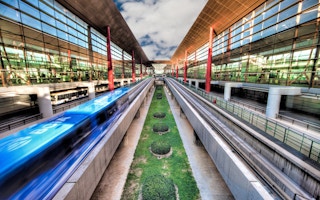Beijingers enjoyed clean air and blue skies earlier this month, as they usually do when big things happen in the city, such as the APEC Economic Leaders’ Meeting and convenings of the national congresses. This time it was the Belt and Road Forum for International Cooperation.
The Forum discussed the Belt and Road Initiative (BRI), China’s massive infrastructure plan to develop railways, bridges, ports and more to foster trade and connectivity throughout Asia and Europe. The question now is: Will China help the BRI develop the kind of infrastructure that protects the health and prosperity of its people in years to come, or one that puts them and the global environment in jeopardy?
Belt and Road Initiative: An ambitious plan
According to the Asian Development Bank, infrastructure investment needs in developing Asia and the Pacific will exceed $26 trillion through 2030, or $1.7 trillion per year. The shortage of infrastructure in the region is believed to be the bottleneck for economic growth and social development.
At the Belt and Road Forum, President Xi committed an additional RMB 100 billion (about $14.5 billion) to the $40 billion Silk Road Fund, and instructed Chinese financial institutions to put in RMB 680 billion (about $100 billion) into Belt and Road projects. He also promised RMB 60 billion ($9.2 billion) to developing countries in the region in the coming three years (see figure below for details on the new commitments).
Taking account of investment already pledged by the Asian Infrastructure Investment Bank, the investment scale in the region will be significant. And given the coverage of the Belt and Road initiative—64 countries in four continents, with a total population of 4.6 billion (about 62 per cent of world’s total)—China’s grand infrastructure plan could potentially boost development and reduce poverty far beyond its borders.
What will that growth look like?
A key challenge, however, will be to do so in an environmentally sustainable manner. Reckless infrastructure building could bring ecological disaster to communities, while unchecked greenhouse gas emissions would fuel dangerous climate change. Last month, four Chinese ministries issued guidelines calling for a “green Belt and Road.” Here are four ways China could imbue sustainability into its massive infrastructure plan:
-
Promote sustainable development abroad by drawing on its own experience. In 2015, China’s investment to green sectors reached $400 billion, and the country plans to spend at least $360 billion on renewable energy within its borders by 2020. An increasing number of Chinese renewable energy firms are investing overseas. Through the BRI, China can promote and demonstrate green growth on a larger scale by supplying cheap renewable energy equipment to other countries and providing valuable lessons to help other BRI countries implement renewable energy and reduce emissions, as China has.
-
Help other BRI countries green their financial systems. By adopting a coordinated approach and mobilising think tanks and academic institutions through platforms such as the China Council for International Cooperation on Environment and Development (CCICED), China developed a range of measures to transform its financial system that were later codified in the Guidelines for Establishing the Green Financial System.
China is the only country that has set up a robust green credit system in the banking sector to channel loans to green business. China is also setting up a national green development fund and provincial green funds to provide equity for green businesses, and its green bond market expanded to $36.2 billion, or 39 per cent of world’s total, in 2016, channelling long-term finance to sustainable infrastructure. Through the BRI, China can help other countries adopt similar measures to green their own financial systems.“
Will China help the BRI develop the kind of infrastructure that protects the health and prosperity of its people in years to come, or one that puts them and the global environment in jeopardy?
-
Ensure that new infrastructure it finances in the region is low-carbon and climate-resilient. With a decades-long life span, energy infrastructure can lock-in carbon emissions for the long term and run the risk of becoming a stranded asset when climate and environmental regulations tighten. A common misperception about low-carbon infrastructure investments is that they’ll increase costs. The New Climate Economy Commission’s report Bettter Growth, Better Climate reveals that building sustainability into infrastructure across cities, land use and energy systems will increase capital costs by five per cent from a business-as-usual scenario, but savings from future spending on climate mitigation and adaptation plus public health and other social benefits will be enormous.
-
Ensure investments in BRI countries comply with high environmental and social governance (ESG) standards. Various ministries of the Chinese government and industry associations issued guidelines to upgrade environmental and social risk management. Importantly, these guidelines are voluntary, so close monitoring, including by stakeholders in the countries where investments are taking place, will be necessary to ensure that firms are taking them seriously. To this end, China could set up a Belt and Road ESG capacity-building program with think tanks and multilateral institutions to educate Chinese firms as well as stakeholders in investment recipient countries.
The road ahead
The Joint Communique released after the Belt and Road Forum noted that the parties involved are determined to prevent the degradation of the planet, to manage natural resources in an equitable and sustainable manner, and to achieve comprehensive, balanced and sustainable development of economy, society and environment. The world is watching as China sets out to fulfill its grand vision for the region’s infrastructure.
Shouqing Zhu is Senior Associate, Sustainable Finance at WRI China. This post is republished from the WRI blog.












